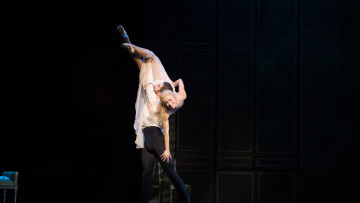How to feed your growing dancer
Growing is hard work, and feeding a growing teenager can present big challenges for the masterchefs in our lives. Then throw a dance training schedule into the mix… We don’t blame you for scratching your head when working out how to plan your meals! To help with this all-consuming (pun intended) issue, we spoke to Sports Dietitian of 17 years, Lauren James about how to nourish a growing dancer.
“What’s unique about dancers is there’s such a high energy cost to their daily routine. Dancing requires a lot of fuel and this also needs to be balanced with the visual and aesthetic component in keeping their physique in peak condition,” she says.
So what exactly should a dancer be eating to achieve this? Lauren advises a balanced diet which prioritises the following:

#1. Carbs
Not the sugary variety though! When we talk carbs, we’re aiming for the good quality stuff: rice, pasta, grainy breads, quinoa, couscous, potato, sweet potato, breakfast cereals and wraps all give a dancer the long-lasting energy they need to make it through the day.

#2. Protein
Protein intake needs to be spaced out over the day, so unfortunately that giant porterhouse for dinner alone won’t cut it! Drip-feeding your protein helps the body utilise protein more effectively, aiding in recovery and growth associated with adolescence and teenage years.

#3. Good fats
Nuts, seeds, avocado, fish and eggs all contain good fats, particularly omega 3s, that have anti-inflammatory properties. Eating more of these foods will mean giving a dancer’s joints a bit of love for quicker recovery, especially in those tiny cushions in their feet and ankles.

#4. Dairy and dairy alternatives
Sustaining a bone injury is a dancer’s worst nightmare, so their calcium intake needs to be high. Aim for 3 to 4 serves a day from calcium rich foods like dairy products. If they’re at school all day, make sure you find a way to keep everything cool – an ice pack or access to a fridge (such as in our Academy building) should do just the trick.
Vegan? No problem – you’ll just need to find a calcium fortified milk alternative. Not all milk alternatives are created equal, so check the product branding to ensure they’re getting all the calcium they need. Otherwise, your dancer will need at least 3kg of broccoli to reach their daily intake!

#5. Fruits and veggies
This isn’t just important for our dancers, it’s vital for everyone to get their 2- and 5-a-day! Your immune system will thank you for it.

#6. Snacks
In a perfect world, dancers would be able to eat whenever and wherever it suited them. However, we know that’s definitely not the case when school, training, rehearsals and performing come into the picture. It’s therefore recommended to prepare plenty of snacks to keep them going through the day.
For those who prefer solid food or don’t love the sloshy feeling a liquid snack provides, try a bliss ball, sandwich or sushi – small, mighty and packed full of nutrients. For those who don’t like feeling too full right before going into the studio, try a smoothie or some fruit and yoghurt.
This advice is general in nature and does not apply to a dancer’s individual circumstances.

Enjoyed this article? Click here to read more Boys in Ballet Week content!
Hero image: Photo by Daniel Gold, sourced from Unsplash.com.
Images: Sheri Silver, Inigo De la Maza, Caroline Attwood, Erol Ahmed, FOODISM360, Julian Hochgesang. All images are sourced from Unsplash.com.
#Related

Media
Passion Unleashed: Dangerous Liaisons Opens at the Thomas Dixon Centre
Extra Performances Added


